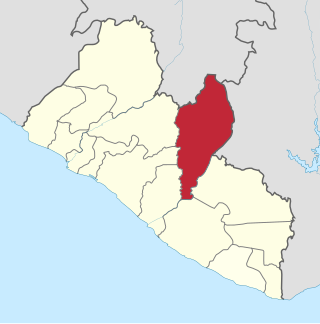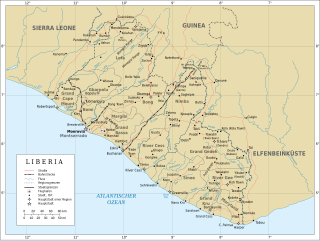
Transport in Liberia consist of 266 miles of railways, 6,580 miles of highways, seaports, 29 airports and 2 miles of pipeline for oil transportation. Busses and taxis are the main forms of ground transportation in and around Monrovia. Charter boats are also available.

Montserrado County is a county in the northwestern portion of the West African nation of Liberia containing its national capital, Monrovia. One of 15 counties that comprise the first-level of administrative division in the nation, it has 17 sub political districts. As of the 2022 Census, it had a population of 1,920,914, making it the most populous county in Liberia. The area of the county measures 1,912.7 square kilometres (738.5 sq mi), the smallest in the country. Bensonville serves as the capital.

Grand Cape Mount is a county in the northwestern portion of the West African nation of Liberia. One of 15 counties that constitute the first-level of administrative division in the nation, it has five districts. Robertsport serves as the capital with the area of the county measuring 5,162 square kilometres (1,993 sq mi). As of the 2008 Census, it had a population of 129,817, making it the eighth most populous county in Liberia. The county is bordered by Gbarpolu County to the northeast and Bomi County to the southeast. The northern part of Grand Cape Mount borders the nation of Sierra Leone, while to the west lies the Atlantic Ocean.

Buchanan, also previously known as Grand Bassa on some maps, is the third largest city in Liberia, lying on Waterhouse Bay, part of the Atlantic Ocean. As of the 2008 census, Buchanan had a population of 34,270. Of this, 16,984 were male and 17,286 female.
Yekepa is a town in northern Nimba County in Liberia, lying near the Guinean border. It was the base for Lamco's iron ore mining operation until it was destroyed in the First Liberian Civil War which lasted from 1989 to 1997. Nearby Guesthouse Hill is one of the highest points in the nation. The community is home to the African Bible College University. Despite some controversy, international steel company Arcelor Mittal was given approval to begin restoring the once prosperous mining town in May 2007. The reconstruction was to include a hospital, schools and other facilities for the township. However, due to fluctuations in world iron prices, much of the redevelopment never happened, and less than a decade later, much of the site had been abandoned once again.
Sanniquellie is a city and the capital of Nimba County and Sanniquellie-Mahn District, Liberia. It is located in the north-east of the country at coordinates 07°21'49" N 008°42'40" W. The average altitude of the city is 420 metres above the sea level. As of the 2008 national census, the population stood at 11,415. The most represented tribes are Mano, Gio and Mandingo.

Nimba County is a county in northeastern Liberia that shares borders with the Republic of Côte d'Ivoire in the East and the Republic of Guinea in the Northwest. Its capital city is Sanniquellie and its most populous city is Ganta. With the county's area measuring 11,551 square kilometres (4,460 sq mi), Nimba is the largest of Liberia's 15 counties. The county has six statutory districts. As of the 2022 Census, it had a population of 621,841, making it the second most-populous county in Liberia.

Bong is a county in the north-central portion of the West African nation of Liberia. One of 15 counties that comprise the first-level of administrative division in the nation, it has twelve districts. Gbarnga serves as the capital. The area of the county measures 8,772 square kilometres (3,387 sq mi). As of the 2022 Census, it had a population of 467,502, making it the third-most populous county in Liberia. The county was organized in 1964 and is important for its mining industry.

James Skivring Smith was a Liberian politician who served as the sixth president of Liberia from 1871 to 1872. Prior to this, he served as the eighth vice president of Liberia from 1870 to 1871 under President Edward James Roye and as Secretary of State from 1856 to 1860 in the cabinet of President Stephen Allen Benson. He was a member of the True Whig Party.
Iron ore production in Africa is dominated by South Africa, Mauritania and Algeria. Many countries possess iron ore deposits that are as yet untapped/unmined. Countries and companies currently involved in production are listed here; measurements are in tonnes per annum(year).

The Liberian-American-Swedish Mining Company (LAMCO) is a defunct Liberian corporation that mined for iron ore in the Nimba range in Liberia during the second half of the twentieth century. Founded in 1955 by American and Swedish investors, the company established the first large-scale mining operation in Liberia following the discovery in the 1950s of the Nimba ore body by geologist Sandy Clarke.
Edina is a city in District 1 of Grand Bassa County, Liberia. Located on the central portion of the Atlantic Coast of Liberia on the north shore of the mouth of the St. John River, it is about 3.5 miles (5.6 km) north of Grand Bassa's capitol of Buchanan. Settled in 1832, Samuel A.L. Johnson has been the city's mayor since 2018. The community is named after Edinburgh, Scotland, which provided monetary support for the foundation of the settlement.
Railway stations in Guinea include:
In March 2010, the Freeport of Monrovia became ISPS Compliant and moved from Security Level 2 to Security Level 1 in July 2010. The Freeport of Monrovia awarded Operations Contract to APM Terminal to handle port operations, which includes container handling, cargo handling, and marine.

Liberia is divided into fifteen first-level administrative divisions called counties, which, in turn, are subdivided into a total of 90 second-level administrative divisions called districts and further subdivided into third-level administrative divisions called clans.

Railways in Liberia comprised two lines from the port of Monrovia in the northeast, and one line from the port of Buchanan in the centre. The lines were built principally to transport iron ore. By 2010, only the Bong mine railway was operational but the Lamco Railway was rebuilt by Arcelor Mittal and put back into service in 2011 as far as Tokadeh, Nimba County, allowing export of iron ore from the company's mine on the Guinean border via the Port of Buchanan.

Rivercess County is a county in the south-central portion of the West African nation of Liberia. One of 15 counties that compose the first-level of administrative division in the nation, it has six districts. Cesstos City serves as the capital with the area of the county measuring 5,594 square kilometres (2,160 sq mi). As of the 2008 Census, it had a population of 71,509, making it the second least populous county in Liberia after Grand Kru County.

The history of rail transport in Liberia began shortly after World War II, when the Freeport of Monrovia was completed, with limited rail access. It had been developed by American military forces.
James Skivring Smith Jr. (1891–1950) was a Liberian politician who served as the 21st vice president of Liberia from 1930 to 1944 under President Edwin Barclay. Prior to this, Smith served as superintendent of Grand Bassa County from 1924 to 1927. Smith was elected as vice president in a special election held in 1930 following the resignation of President Charles D. B. King and Vice President Allen Yancy after mass protests by Liberians and international accusations of government-backed forced labor practices at the Firestone rubber plantation in Liberia. Smith was the son of James Skivring Smith, who served as vice president and president of Liberia in the 19th century.













